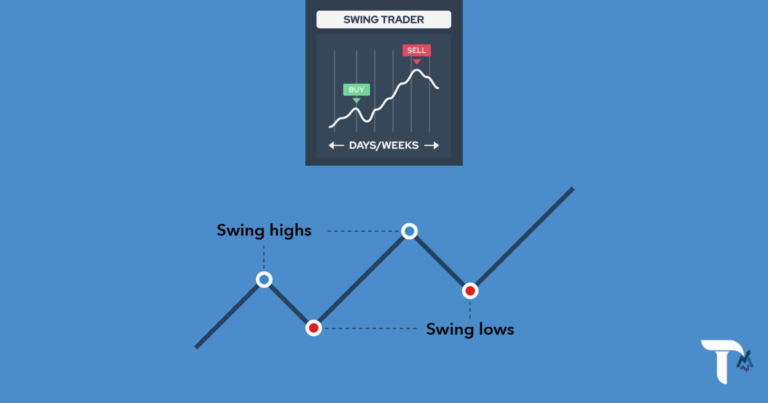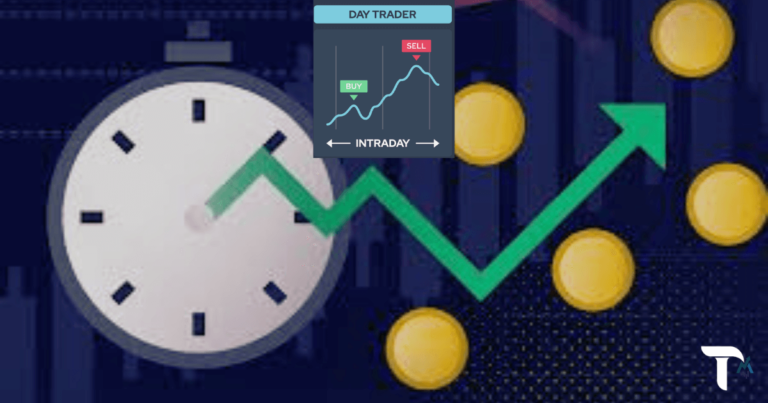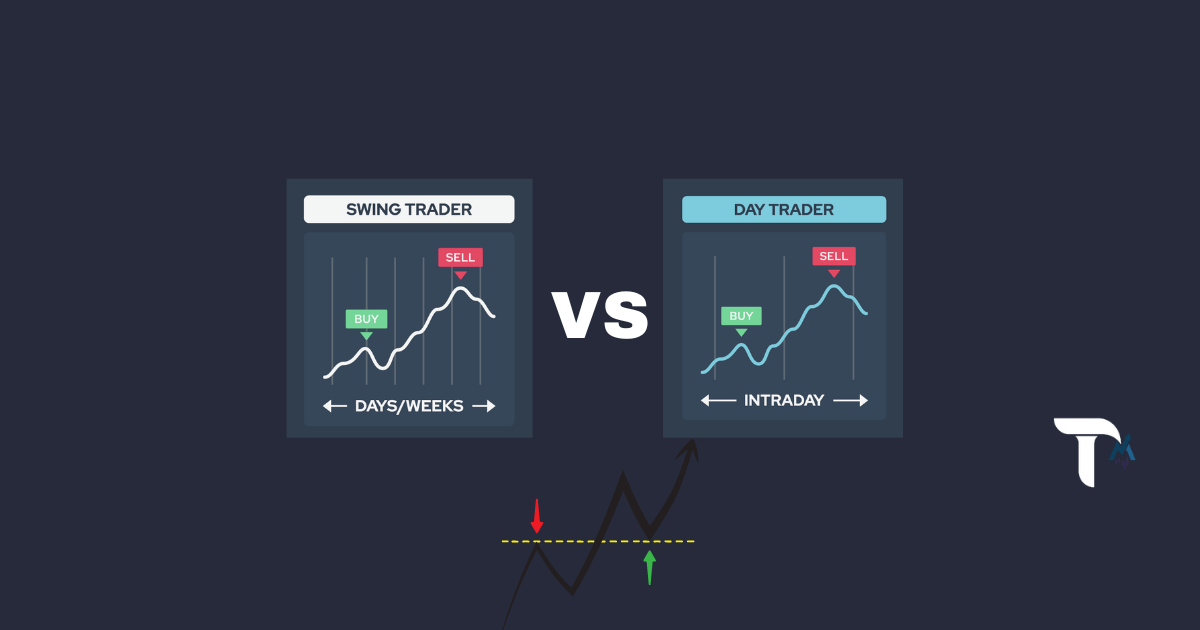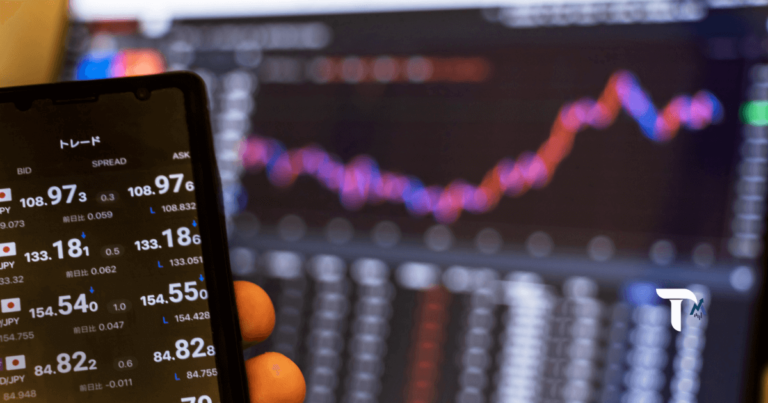What is swing trading vs day trading? How To Trade Them
Are you prepared to enter the financial markets high-adrenaline environment? In this comprehensive guide, we’ll explore the captivating art of What is Swing Trading vs Day Trading. Discover the fundamental differences between these two intriguing trading styles and equip yourself with the knowledge to make informed decisions. Whether you’re seeking to ride the waves of short to medium-term fluctuations with swing trading or embrace the excitement of rapid price movements with day trading, we’ve got you covered. So, fasten your seatbelts and get ready to explore the thrilling possibilities that await in the realm of swing trading vs day trading. Let the journey begin!
| Aspect | Swing Trading | Day Trading |
|---|---|---|
| Duration | Typically held for several days to weeks. | Positions are opened and closed within the same trading day. |
| Objective | Capture price swings or trends over multiple days. | Exploit small intraday price movements. |
| Analysis | Relies more on both technical and fundamental analysis. | Primarily uses technical analysis and intraday chart patterns. |
| Frequency | Fewer trades compared to day trading. Few trades a week to a few trades a month. | Multiple trades daily. |
| Capital Requirement | Generally requires less capital as there’s no need to make numerous trades in a day. | Might require more capital due to the frequency of trades & margin requirements. |
| Stress & Intensity | Generally considered less stressful and time-intensive than day trading. | Can be more stressful due to the need for constant market monitoring. |
| Risk Profile | Overnight risk is present since positions are held for days or weeks. | No overnight risk as positions are closed by the end of the day. |
| Profit Potential | Potential profits or losses accrue over a more extended period and might be larger per trade. | Profits or losses are generally smaller per trade since they capitalize on intraday movements. |
What is Swing Trading vs Day Trading?
In the captivating realm of financial markets, two prominent trading styles take the stage Swing Trading and Day Trading. The aim of both strategies is the same to profit from market fluctuations but they go about it very differently. So, what sets them apart, and which aligns with your trading goals? Let’s delve into the intricacies of swing and day trading to demystify their unique characteristics and uncover the allure they hold for traders.
Swing Trading

The Concept of Swing Trading
Swing Trading is a trading strategy that involves holding positions for several days or weeks, taking advantage of price swings within a broader market trend. Unlike day traders, who focus on short-term price movements, swing traders aim to capture the intermediate price fluctuations during their holding period.
Advantages of Swing Trading
Capitalizing on Price Swings
Swing Trading stands out as an enticing strategy to seize opportunities Price Swings presents. This dynamic approach allows traders to make the most of short to medium-term market fluctuations.
With Swing Trading, flexibility is the name of the game. Traders can swiftly adapt to changing market conditions, tapping into upward and downward trends for potential gains.
Risk management takes centre stage in this method. Setting strict stop-loss and profit-taking points helps minimize risks, ensuring you stay in control of your trades.
Embracing Price Swings unlocks a world of possibilities. You can spread risk and optimize returns by diversifying your investments across assets like stocks, commodities, and ETFs.
So, whether you’re a seasoned trader or a newbie, Swing Trading offers an exciting path to capitalize on market Price Swings. Time to embrace the swings and ride the waves of potential profit!
Lower Time Commitment
Swing Trading emerges as a savior for those seeking a balance between active participation and time constraints. The key allure of this strategy lies in its ability to offer potential gains with a lower time commitment.
Unlike day trading, which demands constant monitoring of the markets, Swing Trading allows traders to operate on a more flexible schedule. This means you can effectively pursue your other responsibilities without missing lucrative opportunities.
By capitalizing on short to medium-term market fluctuations, Swing Trading offers the freedom to adapt to changing conditions without being tied to your computer screen.
So, if you’re looking to explore the financial markets without compromising your time, Swing Trading could be the perfect fit. Embrace the lower time commitment and set sail towards your trading goals!
Reduced Stress and Pressure
Engaging in Swing Trading can offer a breath of fresh air to traders by providing an avenue for reduced stress and pressure. Unlike the frantic pace of day trading, swing traders can take a more relaxed approach, with positions held for short to medium terms. This allows for better decision-making and less emotional strain. Embracing the world of Swing Trading might just lead to a calmer, more enjoyable trading experience. So why not step away from the pressure and swing into a more tranquil trading journey?
Drawbacks of Swing Trading:
Overnight Risk
In Swing Trading, traders encounter the enigmatic challenge of Overnight Risk. Unlike day trading, where all positions are closed before the market closes, swing traders often hold positions overnight, exposing them to potential market swings caused by unforeseen events or news. To tackle this risk, traders can implement stop-loss orders and stay informed about upcoming events. While Overnight Risk is inherent to swing trading, it can be managed strategically, allowing traders to embrace the opportunities that come with this trading style.
Market Volatility
In the dynamic realm of Swing Trading, traders must learn to navigate the ebb and flow of Market Volatility. This inherent unpredictability can either present opportunities or challenges for traders. Embracing a well-thought-out strategy, like setting stop-loss and take-profit levels, can help manage the impact of market fluctuations. By understanding and adapting to Market Volatility, swing traders can ride the waves of potential profit while safeguarding against risks. So, be prepared to surf the tides of volatility and explore the exciting world of swing trading!
Best Practices for Swing Trading
Identifying Swing Trading Opportunities
Technical analysis, chart patterns, and trend identification are pivotal in identifying potential swing trading opportunities.
Setting Entry and Exit Points
Establishing precise entry and exit points based on support and resistance levels or other technical indicators helps execute well-timed trades.
Risk Management Strategies
Implementing risk management techniques, such as setting stop-loss orders and position sizing, safeguards capital and mitigates potential losses.
Day Trading

The Concept of Day Trading
Day Trading is a strategy in which traders open and close positions within the same trading day, avoiding the overnight risk of holding positions overnight. Day traders capitalize on short-term price movements, executing multiple daily trades.
Advantages of Day Trading
Quick Profits
Day Trading offers a captivating pathway to quick profits in the financial markets. With nimble decision-making and rapid execution, day traders aim to capitalize on short-term price movements. This adrenaline-fueled approach requires vigilance, strategy, and risk management. While the allure of rapid gains is enticing, it’s essential to approach day trading with caution and discipline. Successful day traders embrace the excitement of quick profits while acknowledging the inherent risks, making it an exhilarating yet challenging venture for those seeking fast-paced action in the trading world.
No Overnight Risk
By closing all positions before the market closes, day traders eliminate the risks associated with after-hours price fluctuations.
No Swap Fees
Unlike other trading styles that involve holding positions overnight, day traders do not incur swap fees, enhancing their profit potential.
Drawbacks of Day Trading
High Stress and Pressure
Day trading demands split-second decision-making, leading to higher stress levels and requiring traders to stay focused throughout the trading session.
Need for Quick Decision-Making
Day traders must make rapid decisions, leaving limited time for in-depth analysis, which may result in impulsive or emotional trades.
Limited Time for Research and Analysis
Due to the fast-paced nature of day trading, conducting comprehensive research on trades can be challenging within the confines of a single trading session.
Best Practices for Day Trading
Selecting the Right Assets for Day Trading
Highly liquid assets with significant intraday price movements are ideal for day trading, as they offer ample trading opportunities.
Scalping vs Momentum Trading
Day traders can choose between scalping, making numerous rapid-fire trades for small profits, or momentum trading, riding strong price trends during the day.
Utilizing Technical Indicators for Day Trading
Technical indicators, such as moving averages, MACD, and RSI, provide valuable insights for day traders to identify potential entry and exit points.
Key Differences Between Swing Trading and Day Trading
- Timeframe
The primary difference between swing trading and day trading lies in the timeframe of their positions. Swing traders hold trades for several days or weeks, while day traders enter and exit positions on the same day.
- Holding Period
Swing traders endure the overnight risk of holding positions beyond market hours. In contrast, day traders close all positions before the market closes, avoiding this risk.
- Market Analysis
Swing trading requires a broader market analysis to identify longer-term trends. In contrast, day trading focuses on intraday technical analysis and price patterns.
- Profit Potential
Swing traders typically have the potential for larger profits per trade, benefiting from significant price movements over several days. On the other hand, day traders aim for smaller, frequent profits that accumulate over time.
- Risk Exposure
Day traders face less risk exposure as they do not hold positions overnight. Conversely, swing traders are exposed to potential overnight market fluctuations that may impact their positions.
Suitable Markets for Swing Trading and Day Trading

Ideal Markets for Swing Trading
- Stocks
Swing trading stocks are popular due to their liquidity, wide range of trading opportunities, and potential for significant price swings.
- Forex
With its high liquidity and 24-hour trading, the forex market offers ample swing trading opportunities in currency pairs.
- Commodities
Swing trading commodities like gold, oil, and natural gas allows traders to capitalize on macroeconomic trends and geopolitical events.
Ideal Markets for Day Trading
The forex market’s liquidity and volatility make it an ideal playground for day traders looking for intraday price movements.
- Cryptocurrencies
Cryptocurrency markets, known for their high volatility, provide numerous opportunities for day traders seeking quick profits.
- Futures
Day trading futures contracts, such as E-mini S&P 500 or crude oil futures, offer liquidity and price movements that attract day traders.
Choosing the Right Trading Style for You
Assessing Your Risk Tolerance
Understanding your risk tolerance is paramount in choosing the appropriate trading style, as day trading’s higher risk and fast-paced nature may not suit everyone.
Evaluating Time Availability
Consider how much time you can dedicate to daily trading, as swing trading requires less monitoring than the constant vigilance required in day trading.
Analyzing Your Trading Goals
Define your financial objectives, whether short-term gains or long-term investments, to align them with the appropriate trading style.
Considering Your Personality Traits
Your personality traits, such as patience, discipline, and adaptability, can influence the trading style that best matches your natural tendencies.
Swing Trading Strategies and Techniques
- Trend Trading
Swing traders often employ trend-following strategies, identifying and riding trends using technical indicators like moving averages and trend lines.
- Support and Resistance Levels
Analyzing support and resistance levels helps swing traders decide when to enter or exit positions.
- Moving Averages
Different moving averages, such as the 50-day and 200-day moving averages, are used by swing traders to spot potential trend reversals and confirm price movements.
- Fibonacci Retracements
Swing traders use Fibonacci retracement levels to identify potential areas of support and resistance based on the Fibonacci sequence.
- Swing Trading with Options
Swing traders may utilize options strategies to hedge positions or enhance their potential returns while managing risk.
Day Trading Strategies and Techniques
- Scalping
Scalpers aim to make quick profits by executing numerous trades within minutes or seconds, leveraging small price movements.
- Breakout Trading
Day traders focus on identifying breakout patterns, where prices move beyond significant support or resistance levels, signalling potential trading opportunities.
- Range Trading
In range-bound markets, day traders identify price channels, buy at the lower boundary, and sell at the upper boundary.
- Volume Analysis
Analyzing trading volume helps day traders gauge the strength of price movements and potential market reversals.
- Gap Trading
Day traders capitalize on price gaps between the previous day’s closing price and the current day’s opening price, seeking profit opportunities.
Combining Swing Trading and Day Trading
Benefits of Diversification
Combining swing and day trading strategies allows traders to diversify their portfolios and reduce overall risk exposure.
How to Implement Both Strategies
Traders can allocate different portions of their capital to swing and day trading based on their risk appetite and time availability.
Managing Risks in a Combined Approach
Implementing robust risk management practices is crucial when combining swing and day trading, ensuring capital preservation and minimizing potential losses.
Conclusion
In conclusion, Swing Trading and Day Trading are two distinct approaches to navigating financial markets’ dynamic and enticing world. Swing traders take advantage of intermediate price swings over days or weeks, while day traders capitalize on intraday price movements. Each style has its advantages, drawbacks, and best practices, making it essential for traders to carefully consider their risk tolerance, time availability, and financial goals before choosing a suitable trading strategy. Trading professionals can better manage the intricacies of the markets and make educated judgements by using the best practices and strategies covered in this article, thereby enhancing their chances of success. Always remember that continuous learning, discipline, and adaptability are the cornerstones of a successful trading journey. May your trading endeavours be rewarding and prosperous.







